|
|
|
Sort Order |
|
|
|
Items / Page
|
|
|
|
|
|
|
| Srl | Item |
| 1 |
ID:
130996
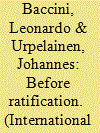

|
|
|
|
|
| Publication |
2014.
|
| Summary/Abstract |
When do international treaties cause domestic policy adjustments? While previous research emphasizes the consequences of treaty ratification, we argue that the need to secure entry into force can induce states to change their policies already before ratification. If a state expects benefits from a treaty, it can increase the probability of foreign ratification by implementing policies that benefit pivotal domestic players within its partner country. Accordingly, studies that focus on policy change after ratification underestimate the importance of treaties and partly misconstrue the causal connection between treaties and policies. We test the theory against data on the relationship between North-South preferential trading agreements (PTAs) and automobile emission standards, finding that developing countries adopt automobile emission standards between the signature and ratification of North-South PTAs.
|
|
|
|
|
|
|
|
|
|
|
|
|
|
|
|
| 2 |
ID:
097512
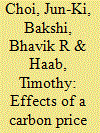

|
|
|
|
|
| Publication |
2010.
|
| Summary/Abstract |
Despite differences in their implementation, most carbon policies aim to have similar outcomes: effectively raising the price of carbon-intensive products relative to non-carbon-intensive products. While it is possible to predict the simple broad-scale economic impacts of raising the price of carbon-intensive products-the demand for non-carbon-intensive products will increase-understanding the economic and environmental impacts of carbon policies throughout the life cycle of both types of products is more difficult. Using the example of a carbon tax, this study proposes a methodology that integrates short-term policy-induced consumer demand changes into the input-output framework to analyze the environmental and economic repercussions of a policy. Environmental repercussions include the direct and the indirect impacts on emissions, materials flow in the economy, and the reliance on various ecosystem goods and services. The approach combines economic data with data about physical flow of fossil fuels between sectors, consumption of natural resources and emissions from each sector. It applies several input-output modeling equations sequentially and uses various levels of aggregation/disaggregation. It is illustrated with the data for the 2002 U.S. economy and physical flows. The framework provides insight into the short-term complex interactions between carbon price and its economic and environmental effects.
|
|
|
|
|
|
|
|
|
|
|
|
|
|
|
|
| 3 |
ID:
176116
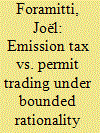

|
|
|
|
|
| Summary/Abstract |
A price on emissions can be achieved through an emission tax or permit trading. The advantages and drawbacks of either instrument are debated. We present an agent-based model to compare their performance under bounded rationality and dynamic markets. It describes firms that face uncertainty about future demand and prices; use heuristic rules to decide production levels, trading prices, and technology adoption; and are heterogeneous in terms of production factors, abatement costs, and trading behavior. Using multiple evaluation criteria and a wide range of parameter values, we find that the main difference between the two policies lies in the fact that permit prices fall after successful abatement. This can lead to higher production levels under permit trading, but can also drive emission-efficient firms out of the market. Scarcity rents under permit trading can further create higher profit rates for firms, the extent of which is shown to depend on the mechanisms for market-clearing and initial allocation.
|
|
|
|
|
|
|
|
|
|
|
|
|
|
|
|
| 4 |
ID:
169890
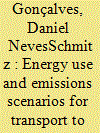

|
|
|
|
|
| Summary/Abstract |
To achieve the mitigation targets discussed under the Paris Agreement, countries must develop studies that not only estimate baselines based on historical data of greenhouse gas (GHG) emissions and energy use, but that also project them considering different levels of ambition and political commitment. This study aims to develop and model scenarios of energy use and GHG emissions from the transport sector until 2030, considering the Brazilian Nationally Determined Contribution (NDC). Three scenarios were developed based on different political commitment. The method is based on a bottom-up approach, requiring multi-sectoral collaborative efforts to not only explain the direct energy use, but also balance the transportation activity and energy between the transport modes, justifying each case in terms of development stage and energy supply capacity. Here, transport sector has been further split up into the highest sector level detail available. At the maximum, GHG emissions could be reduced by 15% (29 Mt CO2e), achieved in scenario 3, whilst there are increases on emissions in scenario 2 (5% or 10 Mt CO2e) and scenario 1 (21% or 42 Mt CO2e). It implies that Brazil has the potential to ratchet up the mitigation targets discussed under the Paris Agreement of the UNFCCC.
|
|
|
|
|
|
|
|
|
|
|
|
|
|
|
|
| 5 |
ID:
177367
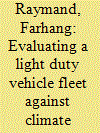

|
|
|
|
|
| Summary/Abstract |
Transportation sector makes up a big share of every country's greenhouse gas (GHG) emissions. The light duty vehicle (LDV) sub-sector, in particular, has experienced a substantial growth in recent years without showing signs of slowing down. Regulations coupled with incentives that make alternate-powertrain vehicles more attractive financially, have become a key policy to keep emissions from this sector in check.
|
|
|
|
|
|
|
|
|
|
|
|
|
|
|
|
| 6 |
ID:
132762
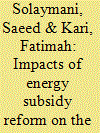

|
|
|
|
|
| Publication |
2014.
|
| Summary/Abstract |
Malaysia is paying a high level of subsidies on the consumption of energy (about 5% of its GDP). Therefore, reforming the energy subsidies, as planned by the government, will have a significant impact on household welfare and energy-intensive sectors, such as the transport sector. This study employs a computable general equilibrium (CGE) model to highlight the transmission channels through which the removal of energy subsidies affects the domestic economy. The findings show that the shock increases real GDP and real investment, while decreasing Malaysian total exports and imports. The removal of energy subsidies also decreases the aggregate energy demand, and, consequently, decreases the level of carbon emissions in the Malaysian economy. In addition, households experience significant falls in their consumption and welfare. The transport sector is significantly influenced through an increase in production costs due to an increase in the prices of intermediate inputs. The total output and total exports of the whole transport sector decrease while its imports increase. In addition, the use of all kinds of transport by households decreases significantly. The Malaysian energy subsidy reform, leads to an initial decrease in CO2 emissions and demand for electricity, gas, and petroleum products in the entire transport sector.
|
|
|
|
|
|
|
|
|
|
|
|
|
|
|
|
| 7 |
ID:
153335
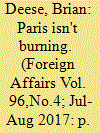

|
|
|
| 8 |
ID:
109454
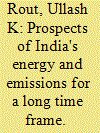

|
|
|
|
|
| Publication |
2011.
|
| Summary/Abstract |
For any nation, sector-wise forecasts of energy demand and emissions are becoming valuable elements in devising its national and international policies relating to energy security, local environment, and global climate change. It is in this context that this work attempts to forecast India's possible energy demands and emissions adopting a key indicator approach on least cost generation expansion optimization methodology for a long time frame. This study developed key indicators for useful-energy demand for end-use sectors such as industry, commerce, and residence. Key indicators for transport sector and non-energy use sectors were developed on transport mobility demand and end-use fuel demand. The main drivers of these key indicators are socio-economic parameters. This work was conducted in a linear programmed (LP) TIMES G5 model on TIMES modeling framework for model horizon of 1990-2100. By the end of the 21st-century, India's energy demands are projected to be about 1825 Mtoe of primary energy, 1263 Mtoe of final energy consumption, 4840 TWh of electricity generations, 723 Mtoe of energy import, and 4414 Mt of CO2 emissions.
|
|
|
|
|
|
|
|
|
|
|
|
|
|
|
|
|
|
|
|
|